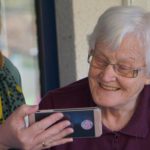 Nursing homes were one of the most badly affected areas during the early months of the Covid pandemic. In many places, telemedicine was part of policies introduced to provide a “protective ring” around care homes to keep the virus out.
Nursing homes were one of the most badly affected areas during the early months of the Covid pandemic. In many places, telemedicine was part of policies introduced to provide a “protective ring” around care homes to keep the virus out.
Research from the University of Missouri Sinclair School of Nursing highlights that the technology had a mixed record, however, as while it provided convenient access to care, it removed some socialization aspects that residents find vital.
The researchers interviewed staff and administrators from 700 nursing homes from across the United States to understand the benefits and challenges of adopting telehealth at scale.
“Transporting a resident to the hospital can be a very traumatic and stressful experience,” the researchers explain. “Whether it’s a fall in the middle of the night or a sudden change in vitals, if a nurse can quickly hop on a Zoom call with a resident and make an assessment, perhaps an intervention plan can be developed that allows the resident to be treated in the nursing home, which saves time, money, and an unnecessary transfer to the hospital.”
Pros and cons
While the convenience of telehealth cannot be disputed, the researchers did identify various challenges that the technology presents. Not least among these is the removal of socialization opportunities among adults who are often in real need of human contact. The authors also highlight how it can cause confusion among residents with cognitive difficulties.
“For some nursing home residents, going to a doctor’s office for a consultation or follow-up appointment can be a fun social event, as it may be their only chance each month to get fresh air and go out in the community, so taking that opportunity away can be difficult for some,” they explain.
“Or for those with cognitive impairments, they might not understand on a telehealth call why or how their doctor is talking to them through a computer screen. While telehealth can be very convenient and beneficial, it should not be viewed as a one-size-fits-all solution, and this study helped us see various nuances involved.”
Speed of adoption
Some of the challenges associated with the technology can also be attributed to the sheer speed that it was rolled out during a pandemic that forced many to cut corners in an attempt to get things done quickly.
“The pandemic highlighted the need for more technical training toward nursing homes that up until now had never used it before,” the researchers explain. “Going forward, there is also the need for better data integration so that when clinicians are on a Zoom call with nursing home residents, they can quickly and easily access medical records such as blood tests or lab results.”
It’s clear that telehealth opens up an array of new opportunities to treat people, and the pandemic has provided an intense crash course in the pros and cons of the technology, and indeed of how it is implemented. Hopefully, that will significantly help us in the post-Covid era.